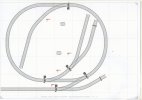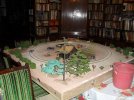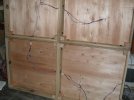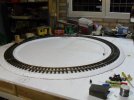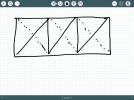playmofire
Registered
At long last, I'm getting round to setting out a layout, not as originally planned 10+ years ago in the garden, but indoors and portable, portable because it will be used at chapel coffee mornings and similar events and at HRCA (Hornby Railway Collectors' Association meetings).
Currently, I've been covering both these type of events laying the track each time and lfting it at the end of each event, both time consuming and limiting in what cvan be done, for example, when trying to operate points and signals electrically, wiring tends to suffer over time.
The layout fits into a 6 foot by 5 foot space (diagram attached, please ignore the two spare pieces of track) and is showing it set up for manual operation of points for the time being.
Space in the car and old age means the layout would have to be in pieces of about 3 feet by 2 feet or maybe a bit bigger. A "skeleton" baseboard approach, i.e. the board just being a support under the pieces of track would be a possible solution.
I have some of what I think is HDF pieces of a suitable size and about 6mm thick which could be used if thought suitable for a "skeleton" system.
Currently, I've been covering both these type of events laying the track each time and lfting it at the end of each event, both time consuming and limiting in what cvan be done, for example, when trying to operate points and signals electrically, wiring tends to suffer over time.
The layout fits into a 6 foot by 5 foot space (diagram attached, please ignore the two spare pieces of track) and is showing it set up for manual operation of points for the time being.
Space in the car and old age means the layout would have to be in pieces of about 3 feet by 2 feet or maybe a bit bigger. A "skeleton" baseboard approach, i.e. the board just being a support under the pieces of track would be a possible solution.
I have some of what I think is HDF pieces of a suitable size and about 6mm thick which could be used if thought suitable for a "skeleton" system.

